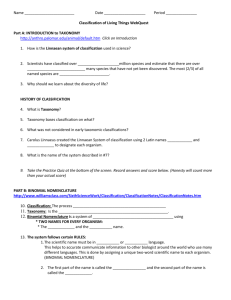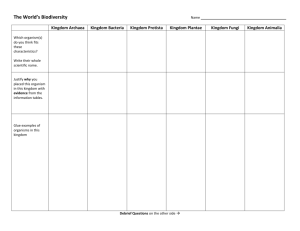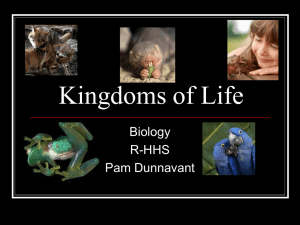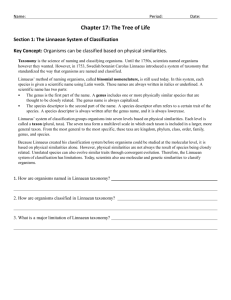Lane Tech College Prep High School
advertisement
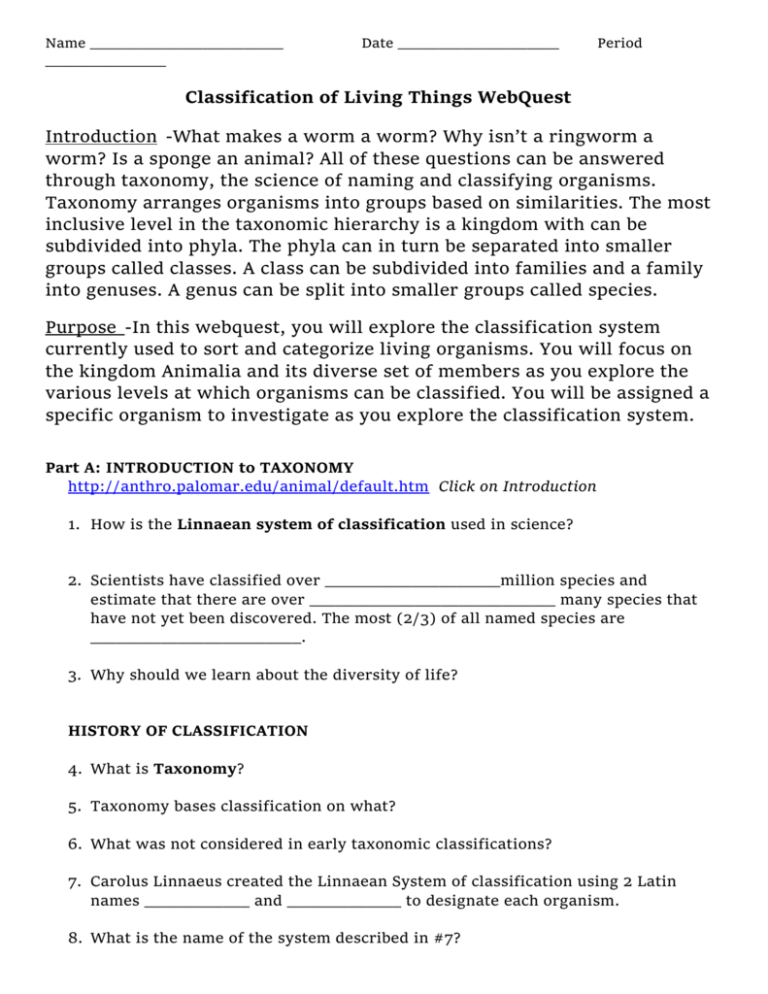
Name ________________________ _______________ Date ____________________ Period Classification of Living Things WebQuest Introduction -What makes a worm a worm? Why isn’t a ringworm a worm? Is a sponge an animal? All of these questions can be answered through taxonomy, the science of naming and classifying organisms. Taxonomy arranges organisms into groups based on similarities. The most inclusive level in the taxonomic hierarchy is a kingdom with can be subdivided into phyla. The phyla can in turn be separated into smaller groups called classes. A class can be subdivided into families and a family into genuses. A genus can be split into smaller groups called species. Purpose -In this webquest, you will explore the classification system currently used to sort and categorize living organisms. You will focus on the kingdom Animalia and its diverse set of members as you explore the various levels at which organisms can be classified. You will be assigned a specific organism to investigate as you explore the classification system. Part A: INTRODUCTION to TAXONOMY http://anthro.palomar.edu/animal/default.htm Click on Introduction 1. How is the Linnaean system of classification used in science? 2. Scientists have classified over ____________________million species and estimate that there are over ____________________________ many species that have not yet been discovered. The most (2/3) of all named species are ________________________. 3. Why should we learn about the diversity of life? HISTORY OF CLASSIFICATION 4. What is Taxonomy? 5. Taxonomy bases classification on what? 6. What was not considered in early taxonomic classifications? 7. Carolus Linnaeus created the Linnaean System of classification using 2 Latin names ____________ and _____________ to designate each organism. 8. What is the name of the system described in #7? 9. Take the Practice Quiz at the bottom of the screen. Record answers and score below. (Honesty will count more than your actual score) PART B: BINOMIAL NOMENCLATURE http://www.warrenhills.org/Page/6542 - scroll down to Chapter 18 and download the document titled “Taxonomy Webquest Notes” 10. Classification: The process _____________________________________________ 11. Taxonomy: Is the _____________________________________________________. 12. Binomial Nomenclature is a system of _______________________________________ using * TWO NAMES FOR EVERY ORGANISM: * The _____________ and the ___________ name. 13. The system follows certain RULES: 1. The scientific name must be in ___________ or ___________ language. This helps to accurate communicate information to other biologist around the world who use many different languages. This is done by assigning a unique two-word scientific name to each organism. (BINOMIAL NOMENCLATURE) 2. The first part of the name is called the ________________ and the second part of the name is called the _____________. 3. The Genus name refers to the relatively small group of organisms to which a particular type of organism belongs. The SECOND part of the name is the SPECIES. (SPECIES means ___________________) The Species name is usually a Latin description of some important characteristic of the organism. 14.What are the advantages of using a universal taxonomic system: 1. ____________________________ 2. ____________________________ 3. ____________________________ 15. What does Modern Taxonomy use to classify? 1. ____________________________ 2. ____________________________ 3. ____________________________ 4. ____________________________ 5. ____________________________ 6. ____________________________ 16.What is Phylogeny? 17. What is a Phylogenic Tree? Part C : KINGDOMS Directions: Open the website: http://www.ric.edu/faculty/ptiskus/Six_Kingdoms/Index.htm Answer the following questions: 1. How many Kingdoms are there? ____________ 2. List them: ___________________________________________________________________ _________________________________________________________________________ ______ 3. How are organisms placed in their Kingdoms? (There are 3 reasons listed) a. b. c. Plant Kingdom List 3 Facts about this Kingdom: 1. 2. 3. Give two examples of members of this kingdom: 1. 2. What are autotrophs? ______________________________________________________ Animal Kingdom List 3 Facts about this Kingdom: 1. 2. 3. Give two examples of members of this kingdom: 1. 2. What is the scientific name of the Tiger shown? _________________ Archaebacteria 1. How did scientists find these bacteria? _________________________________________ 2. Where do they like to live? ___________________________________________________ _________________________________________________________________________ ____ Give two examples of members of this kingdom: 1. 2. Eubacteria: List 3 Facts about this Kingdom: 1. 2. 3. Give two examples of members of this kingdom: 1. 2. How many cells big are Eubacteria? _______________ Fungi: List 3 Facts about this Kingdom: 1. 2. 3. Give two examples of members of this kingdom: 1. 2. How are Fungi different from Plants? ________________________________________ Protists: List 3 Facts about this Kingdom: 1. 2. 3. Conclusion Questions 1. To which kingdom would an organism belong if it is a. Prokaryotic, unicellular, and has a cell wall? b. Photosynthetic, aquatic, unicellular? c. Photosynthetic, multicellular, and terrestrial? d. Heterotrophic, multicellular, and ingestive? 2. Based on the binomial classification system, the mosquito, Anopheles punctulatus, is most closely related in structure to a. Culex pipiens b. Anopheles quadrimaculatus c. Ades aeqypti d. Aedes sollicitans 3. Which of the classification groups would contain the most similar members? Explain your answer. 4. How are all of the organisms observed in this activity similar? PART C: HEIRARCHIAL CLASSIFICATION 18. List the hierarchy of classification from largest to smallest.




